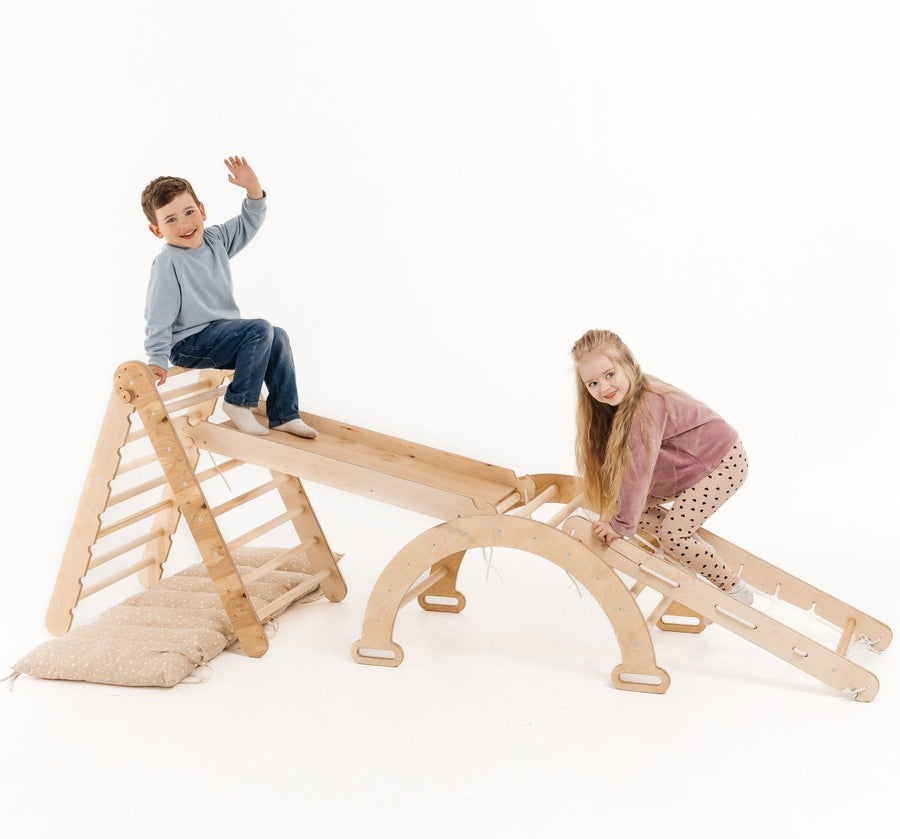Building Blocks of Growth: The Integral Role of Montessori Shelves
Introduction: The Power of Shelves in Child Development
In every family home, certain elements transform the space into a nurturing and thriving environment, especially for young ones. Shelves are one such element, often overlooked but deeply influential in creating a setting that promotes exploration, growth, and independence. Not just any shelves, but specifically, Montessori shelves. The impact of these carefully designed shelves reaches beyond mere storage functionality; they are essential tools that stimulate a child's natural curiosity and promote their development. This article delves into what makes these shelves so crucial to a child's development, their unique features, and how they cater to a child's evolving needs, forming the foundation of a lifelong love for learning.
From discussing the fundamental aspects of what makes up a good shelf, like its height, material, and functionality, to the thoughtful arrangement of toys and books that sparks joy and curiosity in a child, we will unfold the philosophy behind Montessori shelves. More importantly, we will understand how these shelves respect a child's capabilities, allow them to develop at their own pace, and nurture their interests. We'll also take a peek behind the scenes at Goodevas, where our dedication to quality, safety, and nurturing childhood experiences is evident.
Join us on this enlightening journey, whether you are a young mom, an expectant parent, a grandparent, or a friend seeking a thoughtful gift. Prepare to redefine your understanding of shelves and witness how they can transform your home into a vibrant learning space, fostering independence and a love for exploration in your little ones. Let's step into a world where the simplicity of a shelf serves as a stepping stone towards an engaging and nurturing learning journey for your child!

Source: Istockphoto.com
Mastering the Art of Shelf Selection: Height, Material, and Functionality for the Modern Family Home
In the realm of home decor and storage solutions, shelves play a pivotal role. When exploring options, it's essential to consider three crucial factors - height, material, and functionality.
Height is a key aspect in choosing the right shelving solution. For young families, low-height shelves are excellent as they offer easy accessibility for little ones, fostering their sense of independence. These can be effectively utilised in children's rooms or play areas. Conversely, high or wall-mounted shelves are ideal when you want to keep certain items out of children's reach or optimise vertical space, adding an element of visual interest to your rooms.
The material of the shelf further enhances its aesthetic and practical appeal. Wooden shelves, with varieties like oak, maple, or pine, infuse a timeless charm and sturdiness into the decor. They are perfect for heavy items like books or larger toys. Metal shelves offer a sleek, modern feel and are typically easy to clean - an added advantage for busy parents. Glass shelves exude an elegant touch, but they're best kept out of reach from young children due to safety concerns.
Functionality is the final piece of this trifecta. Free standing bookshelves work wonders in a study or child's room, promoting an organised learning environment. Floating shelves, in their myriad of shapes and sizes, offer versatile display opportunities, be it in the living room for family photos or in the kitchen for spice jars. Corner shelves are ingenious solutions for tight spaces, providing storage without obstructing room flow.

Source: Hipcouch.com
More than Storage: Montessori Shelves as Tools for Growth and Exploration
The Montessori approach, widely recognized for its emphasis on creating a child-centric environment, is often brought to life in homes through the use of Montessori shelves. These purposefully designed shelves serve more than just a storage solution, they're a tool to spark natural curiosity and promote independence in children.
The Montessori shelves are an embodiment of 'less is more'. Rather than a cluttered space with toys in every corner, these shelves provide a well-organised and inviting area for children to explore. They are designed to be open and accessible, with the child's favourite and most-used items in plain sight and within easy reach. This design encourages a child's choice, independence, and engagement in their learning journey.
When determining the right height for a Montessori shelf, it's essential to tailor it to the child's developmental stage. Infants best engage with shelves that are about 16” (40 cm) high, allowing easy access as they start to stand. For toddlers, the optimal shelf height increases to between 24” and 32” (60 – 81 cm), while school-age children can comfortably use shelves that stand between 32” and 40” (81 – 101 cm).

Source: Goodevas.com
These shelves are usually made of natural wood, adding a warm and welcoming touch to the space. While most are kept simple to maintain focus on the activities, others may have a back panel of a soft colour. Either way, the main aim is to create a calm, engaging space where a child is inspired to learn and grow.
Nurturing Young Minds: Thoughtful Toy Arrangement on Montessori Shelves
Creating an engaging, organised play space using Montessori shelves can seem like a daunting task, but with some thoughtful strategies, the result is a true investment into your child’s future. The first principle to adopt is one of simplicity. Instead of overloading the shelves with a multitude of toys, carefully select and rotate a few items that align with the child's current interests. This not only maintains order but also sustains the child's curiosity and engagement over time.
Accessibility is the cornerstone of the Montessori approach. Organise the toys on the shelves so that they are within the child's easy reach, fostering their independence and choice in play. Smaller toys can be placed in open trays or baskets for easy access, while larger toys can stand on their own. This encourages the child to return the toy to its designated spot after play, promoting responsibility and orderliness.

Source: Charlestoncrafted.com
To increase engagement, consider disassembling toys before storing them. For example, a building set could be broken down and stored in a basket. This way, the child gets the joy of constructing the toy from scratch during each play session, deepening their involvement and learning experience.
Remember to keep the child's evolving interests and developmental stages in mind when organising the shelves. A well-loved toy at one stage might be replaced by a new fascination in a few months. Regularly revising the toys on display ensures that the shelves continue to be a source of intrigue and learning for the child.
In essence, organising Montessori shelves isn't about achieving a picture-perfect setup. Rather, it's about creating a practical, inviting space that respects the child's capabilities and caters to their curiosity. Whether for your own home or as a thoughtful gift, a well-organised Montessori shelf can set the stage for joyful, independent learning.
Building a Literary Foundation: The Power and Purpose of Montessori Bookshelves for Children
Montessori shelves for books open up a world of imagination and learning for children. Carefully curated and organised, they can serve as an inviting cornerstone for developing early literacy skills. But how and when should you start introducing these shelves? The Montessori approach advocates for initiating the literary journey early on, typically as soon as your child starts showing interest in pictures and stories, often around the age of one.
The selection of books is a key factor in setting up these shelves. Start with sturdy board books for infants and toddlers, filled with vibrant illustrations and simple words. As your child grows, gradually introduce books with more complex storylines and vocabulary. The chosen books should not only align with their developmental stage but also pique their interests—be it dinosaurs, fairy tales, or nature.

Source: Goodevas.com
When organising, arrange books so their front covers are visible, making it easier for the child to make a choice. Adopt a minimalist approach - showcasing a select number of books and frequently switching them out can keep a child's interest alive and sustained. This simplicity reduces visual clutter, helping children make focused choices.
Montessori bookshelves play an invaluable role in fostering independence and a love for reading in children. By providing easy access to books, they allow children to engage with literature at their own pace and on their terms. For parents, these shelves ease the task of instilling reading habits early on. They offer a structured yet flexible way to present books, allowing the child's literary journey to evolve with them.
In essence, Montessori bookshelves offer more than just a place to store books; they provide a platform to cultivate a lifelong love for reading. They're a meaningful addition to any home or a thoughtful gift that contributes to a child's developmental journey, serving as a stepping stone towards independent learning and exploration.
The Intricate Craftsmanship Behind Goodevas Shelves: A Journey from Forest to Your Home
At Goodevas, we craft Montessori bookshelves that combine functionality, child safety, and aesthetic appeal. Designed with birch plywood for its durability and charming texture, our shelves offer a safe environment for children, thanks to their stable structure, rounded corners, and absence of sharp edges. Despite their compact size of 28.3" x 25.6" x 17.7" (72 x 65 x 45 cm) and weight of 26.5 lb (12 kg), they can comfortably hold a suitable number of books, making them ideal for even smaller spaces.

We prioritise sustainable practices, sourcing our birch plywood from responsible Latvian suppliers. Our shelves' robustness and fine grain texture are enhanced by a renewable lignin adhesive, which strengthens the product and lowers our environmental footprint.
Recognizing the potential harm of certain chemicals commonly found in wood adhesives, we've notably curtailed the use of formaldehyde in our manufacturing process. This conscious decision underscores our commitment to safeguarding indoor air quality and prioritising the health of your family. To illustrate our process and commitment further, we have meticulously crafted an informative infographic for your perusal and understanding.
In addition to these steps, all of our products undergo stringent lab tests conducted by the EU government to secure the rights to sell products made out of wood for children, achieving the coveted CE certification. These assessments encompass chemical, mechanical, and other safety tests, underlining that our products either meet the standards or they don’t. Furthermore, our products also hold the CPC certification (Children's Product Certificate), permitting the same selling rights in the USA.
We take immense pride in presenting you with our distinguished certificates for several of our products obtained from a reputable laboratory in Ukraine,“ETALON” (PE ICLR), which is Accredited by the National Accreditation Agency of Ukraine for compliance with the State Standards of Ukraine (DSTU) EN ISO/IEC 17025:2019:


Furthermore, each shelf is carefully finished with a blend of natural oils and waxes, making them easy to clean, moisture and dirt resistant, and ensuring their long shelf life (pun intended). Our unwavering commitment to quality and safety guides every step of our process, from material sourcing to quality control checks, promising a product that meets high standards. Additionally, all of our products went through strict lab tests conducted by the EU government to obtain the rights to sell products made out of wood for children (CE certification). These include chemical, mechanical, and other safety tests, while the products either pass or they don’t. They’re also CPC-certified for the same selling rights in the USA (Children’s Product Certificate).
Final thoughts: Elevating Shelves, Enriching Lives
As we've explored, shelves in our homes, especially Montessori shelves, extend beyond mere storage, becoming instrumental in fostering children's curiosity, growth, and independence. These shelves, designed with low height, accessible layout, and natural materials, create an inviting world that respects and nurtures a child's interests.
Strategic toy arrangement and the use of Montessori bookshelves can spark engagement and cultivate early literacy skills. When paired with thoughtful selection of toys and books that align with the child's developmental stage, these shelves transform into significant learning tools.
To quote the profound wisdom of Maria Montessori, 'The environment must be rich in motives which lend interest to activity and invite the child to conduct his own experiences.' Our in-depth exploration of Montessori shelves offers a tangible manifestation of this enlightening philosophy within our living spaces, paving the way for a fruitful journey of childhood development.
We trust that you found value and inspiration in this detailed exploration of Montessori shelves. As a token of our appreciation for your time and interest, we are delighted to extend a special offer to our blog readers. Utilise the promotional code from this blog to avail a generous 10% discount on our unparalleled Montessori shelves, thoughtfully designed for your little one's development.
Sources:
1. Jackson, Emmeric “How To Pick The Perfect Montessori Shelf – Everything You Need To Know!”
2. United States Environmental Protection Agency (2023) “Facts about Formaldehyde”
3. Hipcouch (2018)
4. Lillard, Angeline (2007) “Montessori: The Science Behind the Genius”. Oxford University Press
5. Montessori, Maria (1967) “The Absorbent Mind”. Holt, Rinehart and Winston.






Leave a comment